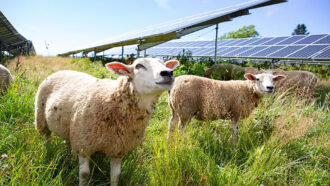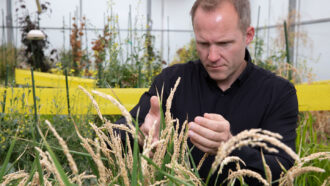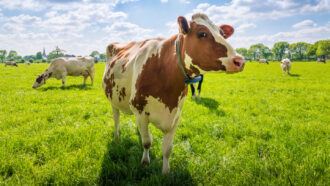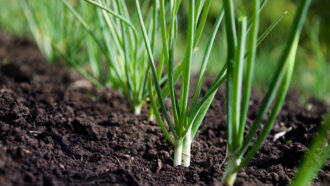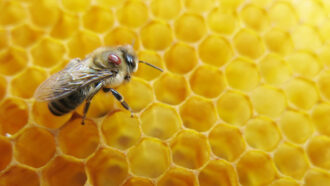Weed wars
Farmers fight unwanted plants among crops
By Roberta Kwok

When Stanley Culpepper was a kid, he spent hours pulling weeds on his family’s farm. “We pulled and pulled and pulled,” he says.
Culpepper started weeding when he was only about 5 or 6 years old. As a teenager, he chopped big weeds down with a hatchet.
Culpepper loved working on the farm, but he didn’t like weeding. He became a scientist to figure out easier ways for farmers to control weeds. “I decided there’s got to be a better way than pulling weeds all your life,” says Culpepper, now a weed scientist at the University of Georgia in Tifton.
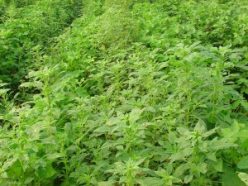
A lot has changed since Culpepper was a kid. About 15 years ago, many more farmers started using a chemical called glyphosate to kill weeds. It worked so well that many farmers thought their problems were solved. But recently, some weeds have become resistant to glyphosate, meaning it’s harder for the chemical to kill the unwanted plants.
Resistant weeds are a big problem. Some can grow 10 feet tall! Scientists have discovered that weeds use all kinds of tricks to fight glyphosate. If the problem gets worse, farmers might not be able to grow as many crops, or they will have to spend more money controlling weeds. Then food could become more expensive.
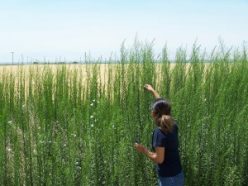
“We’re spoiled in this country because food is cheap and easy to get,” says Patrick Tranel, a weed scientist at the University of Illinois at Urbana-Champaign. But producing all that food is a big challenge. Farmers and scientists will need to work hard to keep weeds under control.
The perfect weed killer
Weeds are plants that people don’t want. When weeds grow on a farm, they hog light, water and nutrients. Then crops don’t grow as well.
Farmers used to get rid of weeds by pulling them or digging them out with a hoe. (In poorer countries, many farmers still do this.) Sometimes farmers would cover the soil to block weeds from getting sunlight or throw salt on the weeds to kill them.
Then scientists found chemicals called herbicides that kill weeds. The best herbicide was glyphosate. But farmers had to be careful because glyphosate could also kill crops. Farmers could spray fields with glyphosate only before planting crops. Otherwise, they had to use special equipment that would ensure glyphosate was applied to weeds only.
In the 1990s, something big happened: Scientists made crops that couldn’t be killed by glyphosate. They changed the plants’ DNA, the genetic instructions that tell cells which molecules to make. If farmers planted these glyphosate-resistant crops, they could spray the herbicide all over the field anytime and kill weeds without harming crops.
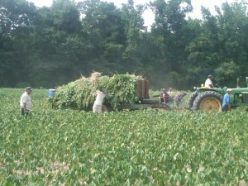
“It became very simple,” says Steve Duke, a plant scientist at the U.S. Department of Agriculture in Oxford, Miss. “Just spray once or twice, kill everything [but your crops].”
Farmers loved those glyphosate-resistant crops. They started planting more and more of them and using more and more glyphosate.
Winning the lottery
Some people thought glyphosate would work forever. But the weeds were evolving. That means their DNA was changing.
Once in a while, changes to a weed’s DNA would allow that weed to survive the glyphosate. The chances of changes like this were very, very small. But when farmers used glyphosate year after year on millions of hectares of crops, “what seems almost impossibly improbable becomes more probable,” Duke says.
Mike Owen, a weed scientist at Iowa State University in Ames, compares the process to a lottery. If one person buys a lottery ticket, his or her chances of winning are tiny. But when millions of people play, chances are good that at least one person will pick the winning combination of numbers. As weeds were sprayed with glyphosate every year, it was like billions of plants were buying lottery tickets over and over, trying to “win” resistance to glyphosate. Eventually, some weeds were going to hit the jackpot.
It didn’t take long for that to happen. In 1996, Australian scientists found a weed called rigid ryegrass that couldn’t be killed with normal levels of glyphosate. In 2001, a researcher in the United States reported another resistant weed, called horseweed. Now at least 21 weed species have evolved glyphosate resistance.
Copy that
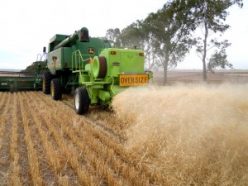
One of these weeds is called palmer pigweed. It’s a leafy plant that can grow two or three inches per day and reach 10 feet tall. “You can sit there and put it on your desk and you can watch it grow,” Culpepper says.
These weeds are especially good at becoming resistant to glyphosate. They pass pieces of DNA to each other through their pollen, tiny particles that fertilize plants. So if one palmer pigweed plant figures out how to fight glyphosate, it can give the information to another palmer pigweed. Each fertilized weed can make about half a million seeds. A lot of those seeds can grow into new resistant weeds.
But how are these weeds changing their DNA to resist glyphosate? Todd Gaines, a weed scientist at the University of Western Australia in Crawley, wanted to find out.
Glyphosate normally kills weeds by attaching to a molecule in plant cells called an enzyme. The enzyme helps the cells make other molecules called amino acids, which the plants need to survive. (Amino acids are the building blocks of proteins, which play a role in everything from building tissues to relaying signals about health and a plant’s environment.) But when glyphosate sticks to the enzyme, the enzyme no longer works.
Gaines’ team found that resistant palmer pigweed plants contain extra copies of a segment of DNA. Called a gene, this DNA piece contains instructions for making the enzyme targeted by glyphosate. Cells of the resistant plant made a lot more of that enzyme — so many that glyphosate couldn’t block all of them. These plants were able to keep growing normally.
Cellular storage shed
Other weeds have different strategies for herbicide resistance. For example, horseweed puts most glyphosate into a plant cell compartment called a vacuole. A vacuole is like the cell’s storage shed, says André d’Avignon, a chemist at Washington University in St. Louis. Once glyphosate is in that compartment, it can’t harm the plant.
D’Avignon thinks the plants might use a molecular pump called a transporter to put glyphosate into the vacuole. The transporter is like a door that lets molecules into the storage shed. Resistant weeds might have more of these doors on their vacuoles or open the doors more often.
In one experiment, d’Avignon’s team cooled down the resistant weeds. When the weeds were colder, they were more likely to be killed by glyphosate. Maybe at lower temperatures the transporter is unable to let as much glyphosate into the vacuoles. So if farmers spray horseweed with glyphosate when the weather is colder, the weed killer might work better.
Outsmarting the weeds
Getting rid of resistant weeds won’t be easy. But farmers have their own tricks.
They can use a mixture of herbicides. If a weed is resistant to one herbicide, maybe a different herbicide will kill it. Some weeds, however, are already resistant to several herbicides. For example, Tranel’s team found weeds in Illinois that resist four different types of weed-killing chemicals.
So farmers will have to use more than one strategy to fight weeds.
Some might plant crops such as rye and then flatten them. The flattened rye will block sunlight from reaching the soil and keep weed seeds from sprouting. Some weed seeds need to be close to the soil’s surface to sprout, so farmers could use a plow to bury the seeds deeper underground.
Scientists at the University of Western Australia are also working on a contraption called a seed destructor. When farmers use machines to harvest their crops, the machines pick up weed seeds and spit them back onto the field. The seed destructor will capture the seeds and grind them up.
But no solution will protect all crops, scientists realize. This means many solutions must be developed to manage the many types of weeds that bully the many types of crops in farms across the world.
And weeds aren’t farmers’ only problem. Insects, such as certain beetles, can eat and weaken crops. By changing the DNA of corn, scientists have made some corn crops that produce toxins that kill specific insects. But just like weeds, some of these insects have started to become resistant to the toxins.
Warp-speed science
If farmers can’t control weeds and insects, they can’t grow as much food. And if they grow less food, food prices could go up.
A lot of weed resistance problems are in corn and soybean crops. You might not think you eat much of those foods. But the next time you visit the supermarket, try reading the labels on products such as cereal, ketchup or cookies. Many contain corn or soy. Animals eat corn and soybeans, too, so the price of meat and eggs depends on those crops.
Weeds affect more than just food production. If farmers have to plow their fields to get rid of weeds, more soil will get washed or blown away. Crops might not grow as well in the leftover soil, and farmers may have to use more chemicals called fertilizers to help the crops grow. That fertilizer can get washed away with the soil into rivers and streams, then end up in the ocean, where it helps organisms called algae grow. The algae eventually fall to the ocean floor, where they’re eaten by bacteria that suck up oxygen in the ocean. The oxygen depletion drives away fish and suffocates bottom-dwelling organisms such as worms and clams.
Weeds come up with ways to fight herbicides so fast that it’s hard to keep up. “Weed science allows us to watch evolution at warp speed,” Tranel says.
Power Words
Weed: A plant that is unwanted.
Herbicide: A chemical that kills plants, typically weeds.
Glyphosate: A specific herbicide that can kill many kinds of weeds. Glyphosate stops plants from producing certain molecules called amino acids, which plants need to survive.
DNA: The genetic instructions that tell cells which molecules to make.
Enzyme: A molecule that helps speed up chemical reactions.
Vacuole: A large compartment in a cell.

